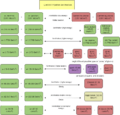Annihilation facts for kids
Annihilation is a special event that happens when a tiny particle meets its "opposite twin" called an antiparticle. When they collide, they don't just bounce off each other. Instead, they disappear and turn into a burst of energy.
This amazing process is a key idea in physics. It shows how matter and antimatter can change into pure energy. Scientists study annihilation to understand more about the universe and its building blocks.
Contents
What Are Particles and Antiparticles?
Everything around us, including you, is made of tiny particles. These are like the basic LEGO bricks of the universe. For example, electrons are particles that orbit the center of atoms. Protons are also particles found in the center of atoms.
An antiparticle is like a particle's opposite twin. It has the same mass as its particle partner but has an opposite electric charge. For instance, the antiparticle of an electron is called a positron. An electron has a negative charge, while a positron has a positive charge. The antiparticle of a proton is an antiproton, which has a negative charge instead of a positive one.
How Does Annihilation Work?
When a particle and its antiparticle meet, they completely destroy each other. This is why it's called "annihilation." They don't just vanish into thin air, though. Their mass is converted into energy. This energy is usually released in the form of light particles called photons, or other high-energy particles.
This process is very efficient at turning mass into energy. It follows Albert Einstein's famous equation, E=mc², which means energy (E) equals mass (m) multiplied by the speed of light squared (c²). This equation shows that even a tiny bit of mass can create a huge amount of energy.
Examples of Annihilation
- Electron-Positron Annihilation: This is one of the most common types of annihilation. When an electron and a positron collide, they turn into two photons (particles of light). These photons shoot off in opposite directions. This process is used in medical imaging, like PET scans (Positron Emission Tomography).
- Proton-Antiproton Annihilation: When a proton and an antiproton meet, they also annihilate. This creates other particles, often called pions, which then quickly decay into other forms of energy, like photons or neutrinos. This type of annihilation releases much more energy than electron-positron annihilation because protons and antiprotons are much heavier.
Where Does Annihilation Happen?
Annihilation happens in many places, from tiny labs to outer space.
- In Particle Accelerators: Scientists create antiparticles in large machines called particle accelerators. They then make particles and antiparticles collide to study the energy and new particles that are created. This helps us understand the fundamental laws of physics.
- In Space: Annihilation can also happen naturally in space. For example, black holes and neutron stars can create conditions where particles and antiparticles are formed. When they meet, they annihilate, releasing powerful bursts of energy that astronomers can detect.
- In Medical Imaging: As mentioned, PET scans use electron-positron annihilation. A patient is given a special substance that emits positrons. When these positrons meet electrons in the body, they annihilate, and the released photons are detected by a scanner to create images of organs and tissues.
Images for kids
See also
 In Spanish: Aniquilación partícula-antipartícula para niños
In Spanish: Aniquilación partícula-antipartícula para niños


